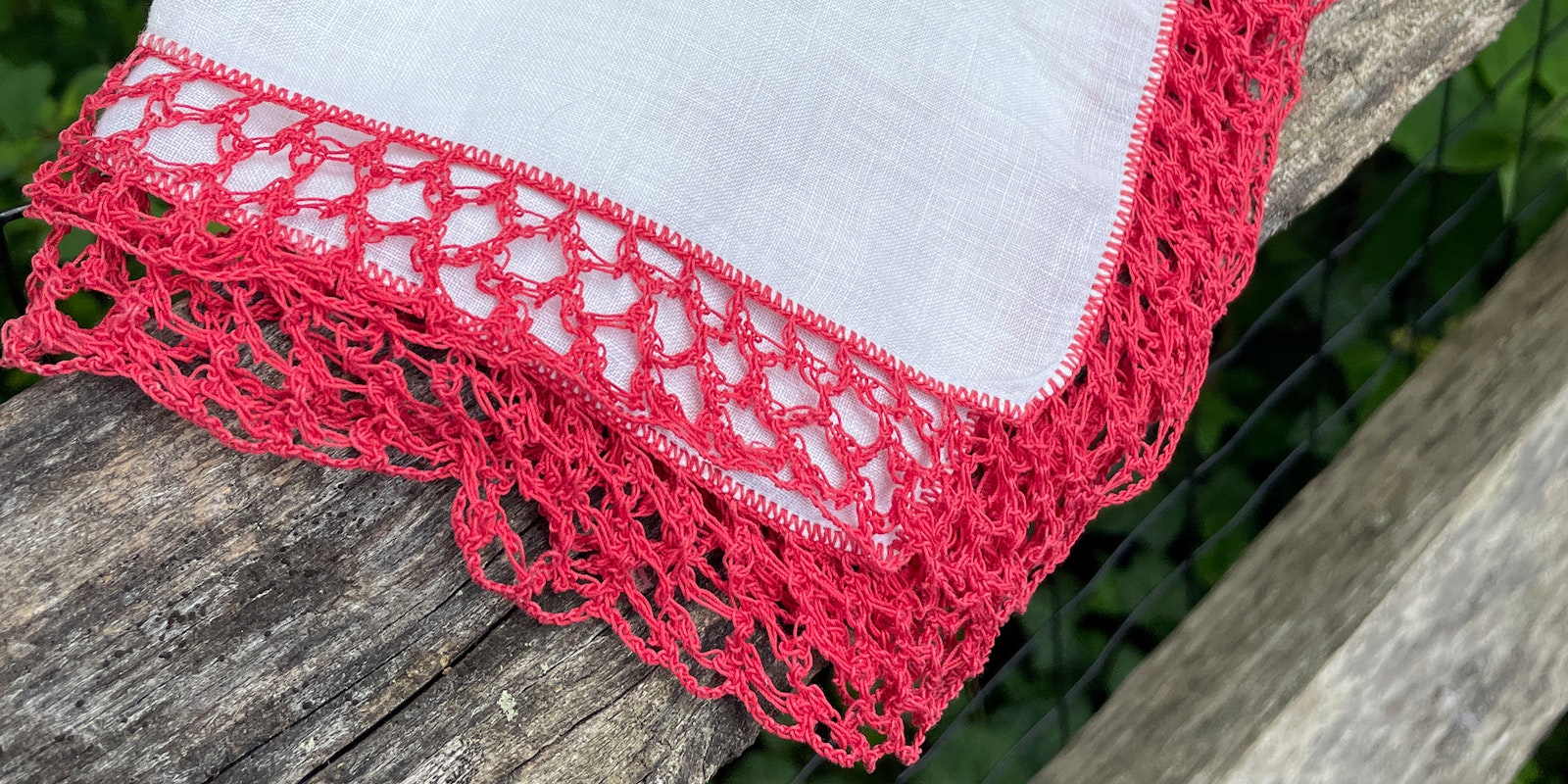Most historians agree that the handkerchief came into general use throughout Europe during the Renaissance (1200–1500). By the late nineteenth century, handkerchiefs were an indispensable part of every woman’s wardrobe. In addition to serving a lady’s needs, kerchiefs (“kerchief,” “bandanna,” and “handkerchief” were used interchangeably) functioned as highly fashionable accessories that signaled wealth, status, class, and fashion acumen.
Nonverbal Messaging
At the beginning of the twentieth century, handkerchiefs were a standard fashion accessory to be carried at most social occasions. These highly functional pieces of cloth shielded a sneeze or dabbed away a tear, but they also signaled all sorts of nonverbal communication. Personal messages could easily be telegraphed by positioning the kerchief covertly: drawing the handkerchief across the cheek (I love you), folding the handkerchief (I wish to speak with you), placing the handkerchief over the shoulder (follow me), or drawing the handkerchief across the eyes (I am sorry) (see note 1).
Decorative Displays of Individuality
Accessorizing one’s attire with a handkerchief was a way to express individuality and uniqueness. Devoid of decoration, the majority of the handkerchiefs available at this time were either ecru or white in color and made of lightweight, closely woven fabrics like linen, muslin, or silk. To add personal touches to the plain white cloth, ladies enjoyed personalizing them by embroidering, crocheting, or tatting the edges with a variety of threads and designs.
Embellished Edgings
Handkerchiefs were widely available in the early twentieth century, and the design, manufacture, and packaging of handkerchiefs was a substantial industry in the United States. Overall designs were simplified and minimal in style, while border embellishments were more elaborate.
Magazines popular at the time, including Needlecraft, featured patterns and design inspiration for decorating home linens. Thread manufacturers promoted their products by publishing booklets of patterns for decorative edgings, and catalogs such as the one published by Bellas Hess & Co. sold plain handkerchiefs for embellishment.
 Crochet handkerchief edgings from Ogden Standard, February 20, 1917, 5.
Crochet handkerchief edgings from Ogden Standard, February 20, 1917, 5.
Artful Borders and Fanciful Gifts
Decorations on handkerchiefs could be flamboyant or subtle, colorful or plain, intricate or subdued. When added to a plain square of cloth, the handworked border became a statement that often transcended the fabric itself. It was common for decorated handkerchiefs to be given as gifts: they were useful presents that signaled affection between friends and family and demonstrated needlework skill.
 In the early twentieth century, handworked hankies were often given as tokens of friendship, during courtship, or for luck. Handkerchief from the author’s collection
In the early twentieth century, handworked hankies were often given as tokens of friendship, during courtship, or for luck. Handkerchief from the author’s collection
The Demise of the Handkerchief
The popularity of the cloth handkerchief declined by the mid-twentieth century. As awareness of airborne germs and concern about infectious viruses became widespread, people began to look for sanitary alternatives. The introduction of an absorbent paper substitute provided a hygienic, convenient way to take care of a stuffy nose or a sudden sneeze. The mass production of these inexpensive cloth tissues ushered in the demise of the trusty, dependable, accessorizing handkerchief.
Collecting Handworked Handkerchiefs
Today, collecting pretty handkerchiefs is a delightful pastime for modern hobbyists. Lucky collectors may discover embellished handkerchiefs stored away in family troves, treasured and handed down through generations. The attentive sleuth can also find vintage handkerchiefs in a number of places, including at estate sales, antiques stores, and thrift shops. There are many online and in-print resources to help the resourceful collector with the identification of origin, time period, and embellishment techniques. It can be such a pleasure to cherish these wonderful little pieces of cloth that hold so much history, memory, and meaning.
Notes
- Helen Gustafson, Hanky Panky: An Intimate History of the Handkerchief (Berkeley, California: Ten Speed Press, 2002), 34.
Resources
- Albrechtsen, Nicky, and Fola Solanke. Scarves. London: Thames and Hudson, 2011.
- Gustafson, Helen. Hanky Panky: An Intimate History of the Handkerchief. Berkeley, California: Ten Speed Press, 2002.
- Murphy, J.J. Children’s Handkerchiefs: A Two Hundred Year History. Atglen, Pennsylvania: Schiffer, 1998.
- O’Hare, Georgina. The Encyclopaedia of Fashion: From 1840 to the 1980s. London: Thames and Hudson, 1986.
- Panati, Charles. Panati’s Extraordinary Origins of Everyday Things. New York: Harper and Row, 1987.
- Wilson, Betty. Printed and Lace Handkerchiefs: Interpreting a Popular 20th Century Collectible. Atglen, Pennsylvania: Schiffer, 2003.
Marsha Borden is a Connecticut, USA-based needleworker and textile artist. She enjoys researching historical textile techniques, materials, and makers. Among her collection of vintage handkerchiefs, her favorites are the ones crocheted with thin thread and tiny metal hooks.

